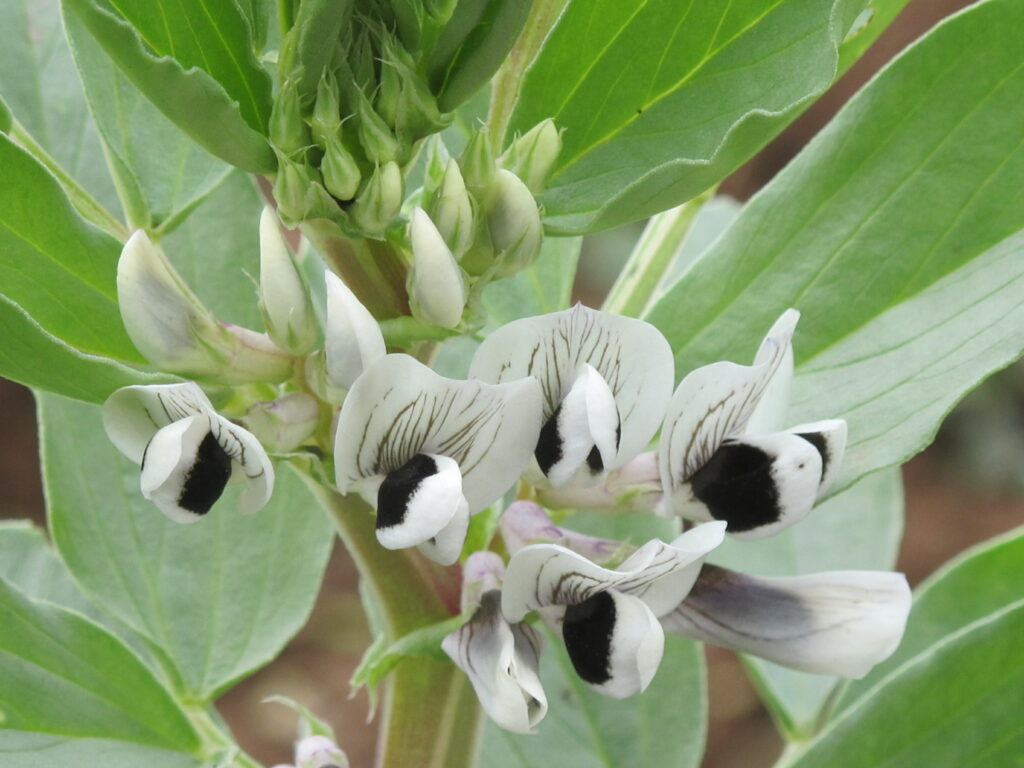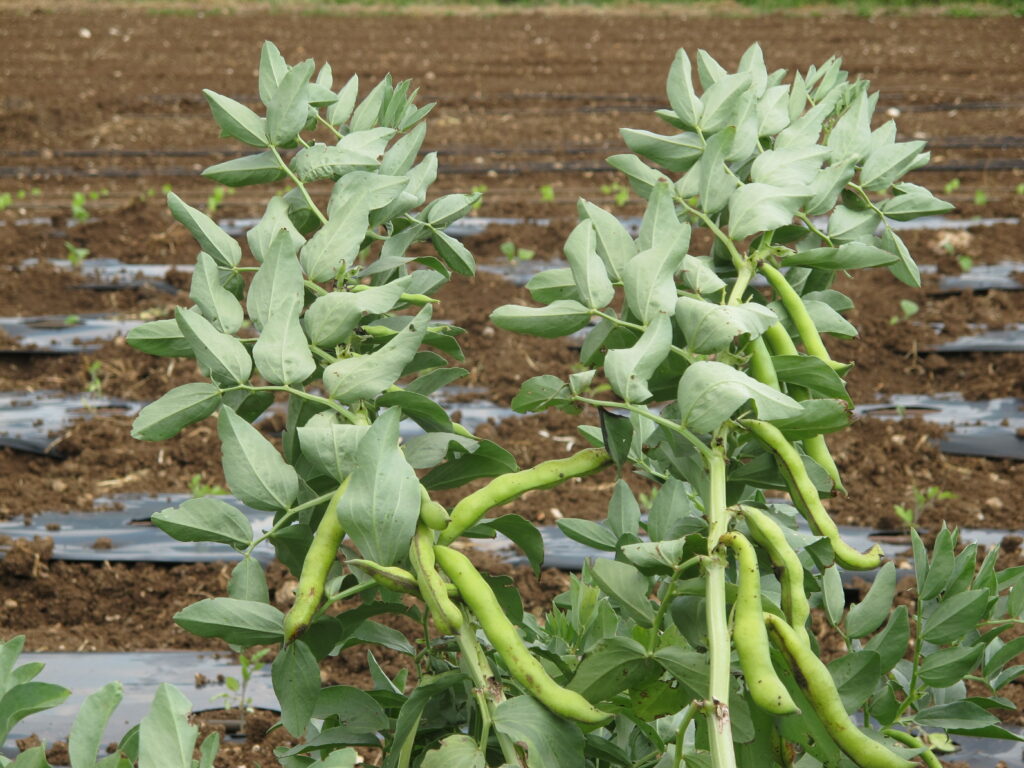The Spring-Is-Nearly-Here seesaw has already started to swing. These past weeks careened between rain and sunshine. This week’s pleasant, sunny days are predicted to be followed by the return of cold and rain coming soon, probably once again alternating with beautiful sunny days and then more cold weather. The greens in Chubeza’s field are fairly overwhelmed by this cold-hot-dry-wet ordeal, giving us one hard time to pick sufficient quantities. Some of them forlornly turned yellow from over-saturation of the soil, others grew verrrry slowly, and some opted to begin flowering, rendering them unsuitable to pick. You probably felt this from the decreased quantity and selection of greens in your boxes. The fresh Spring garlic made its Chubeza debut last week, joined by another distinctive vegetable which traditionally arrives this season but for the past few years has begun yielding in winter – this year already in December. Ladies and gentlemen, please welcome the fava bean!
If you still don’t recognize the fabulous fava, let us casually mention his pedigree – a venerable legume family member – and describe his plump elongated green pods, complete with a soft, cottony inner lining.

Dry and fresh fava beans have been consumed in the Middle East, in North Africa and Southern Europe for thousands of years. Fava fossils have even been found in archeological sites of Mediterranean countries, the most ancient of which in our very own Nazareth dating back to as 6500 BC! Fava served as an important, essential food for all classes. Fava is rich in protein, complex carbohydrates, and dietary fibers, and contains a good amount of iron, folic acid, potassium, magnesium and zinc.
And yet, “Stay away from fava!” cautioned Pythagoras.
What did the renowned sixth century BC Greek philosopher have against one of the most popular vegetables of the time? Pythagoras aficionados and interpreters have offered many hypotheses for this sharp warning. One is that fava is hard to digest, said to be “full of spirit, and taking a part of your soul. If you avoid it, your belly will be less noisy and your dreams calmer.” Despite this unflattering critique, one should not forget that fava contains less sugar than its fellow legumes, such as the green bean.
Another possible reason for Pythagoras to avoid fava could have been the ancient belief that the spirits of the dead can wander into the fava’s pods, making it a popular dish for funeral feasts.
Possibly the fava’s correlation to death is related to the hazardous fava allergy, also known as Favism (from the Latin Vicia faba). This critical allergy results from a genetic deficiency in the G6PD enzyme, which commonly affects populations originating in the Middle East and Mediterranean. (In Israel, it is most prevalent, but not restricted to, Iraqi Jews). Among the some 20% of humans lacking this enzyme, fava consumption can result in severe anemia and even death.
On the other hand, the fava appears to possess chemical components similar to those in quinine medicines used to treat malaria, a once-common disease in Greece and southern Italy. It seems that when the fava-allergy anemia is under control, it fights malaria by reducing the quantity of oxygen within red blood cells, thus slowing its spread.
Another reason why fava should be part of our natural medicine chest is to treat Parkinson’s Disease. Fava naturally contains the L-Dopa amino acid, which becomes the Dopamine neurotransmitter upon reaching the brain. This acts to improve the condition of Parkinson sufferers, a disease resulting from Dopamine deficiency. Even 250 grams of cooked fava has proven to significantly boost the level of Dopamine in the blood, improving the patient’s condition. The largest concentration of L-Dopa is found in fresh fava, particularly in its pods. Dry fava contains a far smaller amount. Research is still in the early stages, thus those considering fava for treating Parkinson’s should consult with their physician.
In our part of the world, there are two traditional varieties of fava – the larger Cypriot and the smaller Egyptian fava, which is almost the size of a pea pod. During Chubeza’s first years, we grew both varieties, but then we met an “in-between” type with medium-sized pods, which we now happily grow. In Egypt, fava is called “Ful Hamam” for a fascinating reason: in medieval times, preparation of the fava was carried out exclusively by those who lived in the area surrounding “the Princess Baths,” the public baths at the site of the Fountain of Mohammed Ali Pasha in Cairo. By day, the water in the great basins was heated for bathing. By night, when the burning coals were still ablaze, the basins were filled with fava beans which cooked overnight on the heat of the coals to provide breakfast for the residents of Cairo.
The fava’s tale began last autumn. There is something beautiful about it, something that returns us in our world of seemingly limitless possibilities to the restraints of seasons and time, and to slower, softer rhythms of life. We seed the fava at the end of autumn from mid-September to December in four rounds, every month or so. We try to bury it deep in the ground before the first rains, when the skies above darken, foreshadowing the impending drizzle. On one hand, we want to avoid watering, but if we seed too early, we’ll lose our crop to the field animals stocking up just then on food for the winter. The raindrops cover the fava with earth, greeting with fanfare their old friends, the big seeds they knew and loved last year.
This encounter results in the speedy appearance of strong, green fava sprouts, which courageously burst forth and continue growing, even as the winter grows colder and rainier and the rest of the world withdraws within itself. The growth is slow and measured. Fava takes its time, growing over an entire winter, patiently and steadily, inching a little taller every week. Favas cover the earth and protect the soil from erosion and the ravages of strong rains. Its dense growth prevents weeds from sprouting. Favas do not require fertilizer, for like the rest of the legume family, fava beans can fix nitrogen for a do-it-yourself fertilizer, enriching the earth in which they grow.
After months of rain, wind and cold, the fava feels something moving inside. Its faultless plant instinct senses the seasons changing, the days growing longer, the changing light, the sun’s locale, and then it knows – it’s show time! The fava debuts with beautiful fabacaea butterfly-like flowers. They are gentle and strong at once, like the fava itself. In strident pastel festivity, they overtake the garden beds as if to say, we’re all clean and dressed up and something wonderful is about to happen! Even when the fava blooms, it takes its time. Why hurry when you can look around, smell the fava, and enjoy life?
The fava bed still looks like it stopped at the flowering stage, while on the surface nothing else has changed. But slowly, almost imperceptibly, a small green boat appears in the flower. This boat will thicken and fatten up until it becomes a seed-carrying pod. We pick them before they ripen, when they’re still green, fresh, sweet and juicy. And that’s when we know spring is here. Right here, in our field, and in your plate.
There are many ways to prepare fresh favas, and despite the suggestion to peel the fava bean (and even double peel), you can certainly cook and even eat fava beans within their pods!
Some simple uses:
– Cook in unsalted water (like blanching peas–the salt hardens the skin).
– Steam fava beans in water and a touch of olive oil, or sauté onion and garlic, add the fava, boiling water, and lemon juice. Cook for 15 minutes till the liquid is absorbed.
– Fava may also be baked slowly in the oven at low heat, together with garlic and such fresh herbs as rosemary, thyme or za’atar on a lightly olive-oiled baking sheet. When the fava is very soft, crush together with the garlic and herbs and spread on bread.
But I must admit, though the recipes sound great, sometimes I don’t get around to preparing them. Because in our house, fava is eaten fresh and raw, like peas, popped straight from the pods and joyfully devoured.
This warm, sunny week, the Hebrew month of Adar Bet arrives to spur us to seek abundant joy, simultaneous with the Moslem month of Ramadan, a month of prayer, charity and kindness.
May chesed, shining countenance and heartfelt unity surround us. May this be the week that our hostages return safely home!
Best wishes,
Alon, Bat-Ami, Dror, Orin, and the entire Chubeza team
_____________________________________________
WHAT’S IN THIS WEEK’S BOXES?
Monday: Swiss chard/kale/spinach/beets, fava beans/snow peas or garden peas/Jerusalem artichokes, lettuce, daikon/turnips/kohlrabi, parsley root/celeriac/celery stalk, potatoes, cauliflower/broccoli/sweet potatoes, parsley/coriander/dill, tomatoes, cucumbers, leeks/onions.
Large box, in addition: Carrots/bell peppers, cabbage, fresh garlic.
FRUIT BOXES: Bananas, oranges, avocados, red apples, pomelit/pink grapefruit.
Wednesday: Fava beans/snow peas or garden peas/Jerusalem artichokes, lettuce, kohlrabi, parsley root/fresh garlic, potatoes/beets, cauliflower/broccoli/cabbage, parsley/coriander/dill, tomatoes, cucumbers, leeks/onions, carrots.
Large box, in addition: Swiss chard/kale/spinach, daikon/turnips, celeriac/celery stalk .
FRUIT BOXES: Bananas, oranges, avocados, red apples, pomelit/pink grapefruit. A special gift – lemons.





